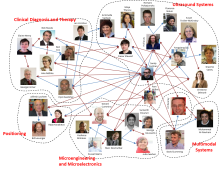SONOPILL Progress - Sandy Cochran
Published: 8 December 2016
It’s a real pleasure finally to write about progress on the Sonopill programme.

It’s a real pleasure finally to write about progress on the Sonopill programme.
Team Building One of the interesting features of a research programme so large, taking in more than 30 people in many different positions from many different disciplines, is that team building and maintenance are lengthy tasks. In fact, to allow any kind of coordinated launch, this had to start in Sonopill even before our EPSRC sponsors had decided if the £6m funding would be awarded.
I still recall, as if it was yesterday, meeting Pam Wilkie, now the Project Manager, to discuss whether she’d consider joining me if Sonopill was funded. Thankfully, she agreed, bringing many excellent skills, including to moderate my own, often over-demanding approach. Similarly, I recall a visit to Florida, a daring thing for a pale-skinned Scot, to meet Holly Lay, an equally pale-skinned exile from Northern parts, to chat about future possibilities. Thankfully, she also agreed in due course to join us, and the programme had its key ultrasound electronics systems engineer.
So, person by person, over the past 21 months, the team has come into being. I won’t name everyone in the text, but they all show up in the diagram below, they’re all important and they’re all working hard towards our research goals.
Critical Compromise I’m also very pleased to be able to write that I’m now seeing the programme generating real research value, both from individual researchers and, maybe more importantly, from interaction between them.
The best example of this relates to the design of the application-specific integrated circuits, ASICs, one of the key structural elements without which Sonopills will be impossible. ASICs allow far more highly-customised electronic functionality to be packed into a far smaller volume than any other device. However, this comes with difficult design, requiring a great deal of expertise, in Sonopill vested in Mohammed Al-Rawhani and Jim Beeley.
But what we’ve just found is that, even with such expertise available, we also need to bring in many other factors, such as the ultrasound systems and transducer design, calling on the redoubtable talents of Holly Lay and Yongqiang Qiu to build a truly integrative sensing system. And even then, we don’t know if we’ll succeed in building systems small enough for our target capsule size, just 10 mm in diameter and 30 mm in length. So we also need to call on Gerard Cummins, one of our microengineers and an expert in small-volume packaging. And so on, across the whole team…
The reality is that the Sonopill programme presents unprecedented challenges across all fronts and in all the themes highlighted in the team picture. That might make some people nervous, but for the researchers in the Sonopill team, it’s the kind of challenge on which they thrive.
As Yuval Noah Harari explains in his thought-provoking book, “Sapiens”, scientific and physical exploration are intimately intertwined and, in a world that has already been thoroughly explored physically, I like to think Sonopill is providing its researchers with opportunities for exploration just like those that might have taken them along unexplored physical paths in the past.
Technical Topics I’ve written almost all I intended, so I’ll leave you for now unapologetic that I’ve addressed mostly people rather than technical topics. Over the coming months and years, every individual in the Sonopill team will contribute to this blog and I’m sure the technical issues that we’re addressing, far beyond the present commercial state of the art, will come to the fore.being. I won’t name everyone in the text, but they all show up in the diagram below, they’re all important and they’re all working hard towards our research goals.
First published: 8 December 2016
<< Blog

